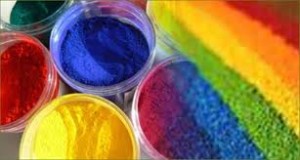
Who would want to have a world without dyes? Dyes have made the textile world vibrant and colorful, giving each piece of fabric a unique personality. The dyeing process has been carried out since times immemorial; however the dyes of today are largely obtained through laboratories and factories rather than from natural sources.
Dyes differ from one another with respect to their resistance to sunlight, washing, perspiration etc; fiber affinity, solubility and manner of application. A few of the dyes are discussed below.
Acid Dyes
One of the modes of classifying dyes is acid dyes and basic dyes. Acid dyes are negatively charged in a solution and occur as an anion. The phenolic groups or sodium salts of sulfonic acids come into the category of acid dyes. These dyes are best suited for polyamide, silk, nylon, wool and modified acrylics. They have zero affinity to cotton cellulose and are therefore not used for cellulosic. The toxicity levels of acid dyes vary with some of them being so safe that they can be used as food color while some having quite high toxicity levels. Acid dyes can be basically classified as follows:
- Strong or leveling acid dye
- Weak or milling acid dye
- Neutral or fast or super milling acid dye
Reactive Dyes
The reactive dyes impart color to cellulose fibers in a big way though they are also used to dye nylon and wool under weakly acidic conditions. A chemical bond is formed with cellulose by this dye and hence it is popularly used in the dyeing of cotton fibers. After the chemical bonding the dye particle becomes a component of the cellulose fiber particle and this gives color fastness to the garment. The three major advantages of reactive dyes can be listed as follows:
- Ease of washing: Garments colored by using reactive dyes can be safely washed with white garments with no fear of imparting color to them.
- Color permanency: The color lent by this dye remains steadfast for long times to come.
- Chemical binding: Reactive dyeing of cotton has become one of the most widely carried out dyeing process because of the property of chemical binding.
Leather Dyes
In the leather industry, a wide range of color tones finishes and styles are needed for making the finished products more attractive. Leather dyes are highly useful in enhancing and improving the shine, look and life of several leather products. It is the anionic dyestuff that is largely used in the leather industry. Different kinds of application like sponging, spraying, brush finishing are adopted to give different looks to leather.
Direct Dyes
Direct dyes are a group of hot water dyes that are used on cotton, linen and rayon. The light fastness of these dyes is a little better than the other dyes though their colorfastness is poor. However, after undergoing certain special- after treatments, the problem of color bleeding can be tackled. Another application of these dyes is their use as biological stains and as pH indicators.
The above mentioned dyes offer just a small peek into the huge and vast world of dyes.